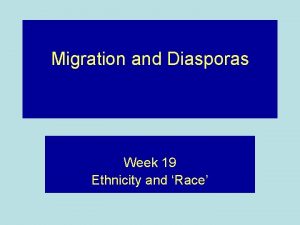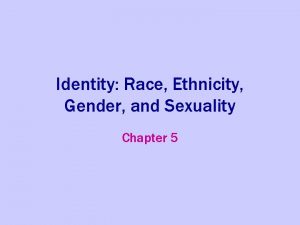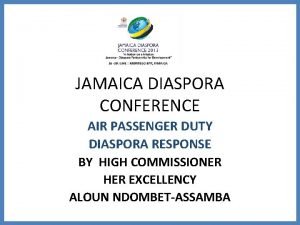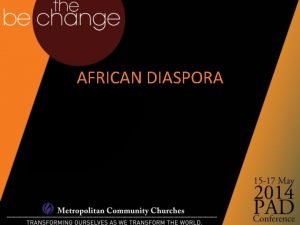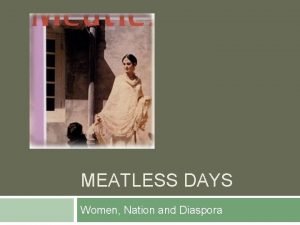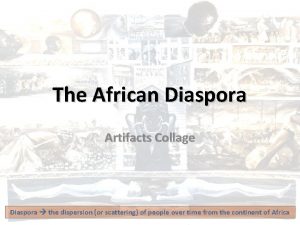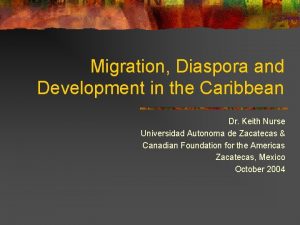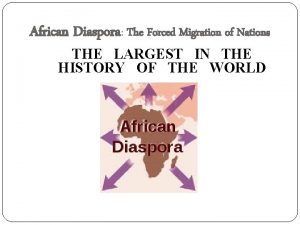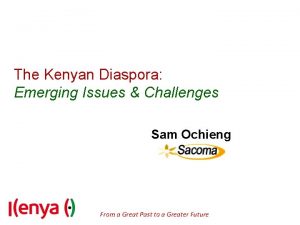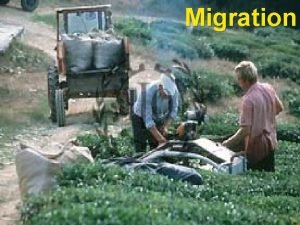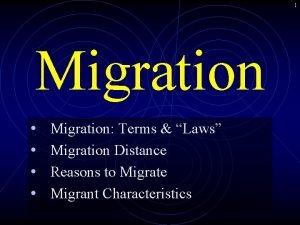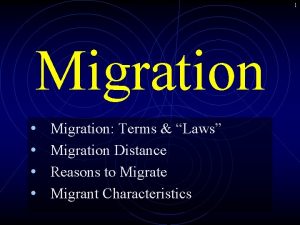Migration AP World History Issues of Migration Diaspora




















- Slides: 20

Migration AP World History

• Issues of Migration Diaspora – A whole ethnic group is moved from a settled area over time – Connotes scattering • Exodus – Depart to somewhere • • • Push – Pull factors Role of language How each societies reacts to the culture and systems of the other – Acculturation – • Some culture exchanged but the groups remain distinct – White stays white and Red stays Red – Assimilation (Romanization, Americanization, Sincification) • The lesser or weaker or smaller numbered society is absorbed into the stronger and is required to become like the stronger culture either by society or by force. – Syncretic (Roman-Greco society following conquest of Romans over Greeks, Creole) • A whole new society is developed from the two • Red and White become Pink. – Accommodation • One culture is allowed to exist within another as it is expected than they will eventually be absorbed or assimilated. This is usually the case with a minority society and culture entering and even conquering another that has higher numbers. It is a practice in tolerance and patience. In the case of the Mongolians in South Asia, they came and conquered but left little in the way of culture that was adopted by the peoples they conquered in this region. Some of their technology was adapted but in most cases was not absorbed. – Conquest

Causes and factors that impact Disease and great pandemics Economic opportunity technologies that advance travel technologies that advance communication Introduction of new philosophies Great leaders New laws

Environment Guides Migration • Mountain barriers frequently serve as linguistic borders – In part of the Alps, speakers of German and Italian live on opposite sides of a major ridge – Portions of mountain rim along the northern edge of the Fertile Crescent form the border between Semitic and Indo-European tongues • Environmental barriers and natural routeways guided linguistic groups along certain paths • Indo-Europeans traveled through low mountain passes to the Indian subcontinent, avoiding the Himalayas and barren Deccan Plateau • In India today, the Indo-European/Dravidian language boundary seems to approximate an ecological boundary • Migrants were often attracted to new lands that seemed environmentally similar to their homelands – They could pursue adaptive strategies known to them – Germanic Indo-Europeans chose familiar temperate zones in America, New Zealand, and Australia – Semitic peoples rarely spread outside arid and semiarid climates – Ancestors of modern Hungarians left grasslands of inner Eurasia for new homes in the grassy Alföld, one of the few prairie areas of Europe

Language as a Historical Source • Historical linguistics can help historians to understand the past. • It is a guide to thought patterns of a people; it helps to explain social and political patterns and historical relationships between groups. • The reconstruction of the migrations of the Indo. Europeans, Bantu, Polynesians, and early Americans is based on linguistic studies. • The similarities and differences in language development that occurred as people moved into new regions and left their original group can tell us much about societal values, social structure, material life, and migration patterns.

Terms used in the study of language • Language — tongues that cannot be mutually understood • Dialects — variant forms of a language that have not lost mutual comprehension – A speaker of English can understand the various dialect of the language – A dialect is distinctive enough in vocabulary and pronunciation to label its speaker – Some 6, 000 languages and many more dialects are spoken today • Lingua franca — a language that spreads over a wide area where it is not the mother tongue – A language of communication and commerce – Swahili language has this status in much of East Africa


Case Studies: Foundations Period of World History, 8000 BCE – 600 CE

Migration vs. Nomadic Lifestyle & Movement of Peoples • • “Out of Africa” movement of man populating the earth Aryans into Indian Subcontinent Bantu migrations within African Continent Religious diasporas of the late classical period including the Jewish and Christian movements • Germanic peoples from Black Sea into Roman Empire across Northern European Plain • Migration period of transition following the fall of the great classical civilizations – Huns vs. Xiong-nu – same peoples? – Vikings migrated although initially were marauders and nomads (Rurik the Rus, Normans)

The Great Migration in Oceania and Indian Ocean • About 4000 years ago Austronesian-speaking peoples expanded eastward from Melanesia to Fiji, Tonga, and Samoa. • They practiced agriculture, had domestic animals, and used complex fishing techniques. • A distinctive pottery style, Lapita, helps to identify their settlements. • From Tonga and Samoa they moved to Polynesia and perhaps westward to Madagascar. • In the many Polynesian islands cultures evolved differently. • Basic common principles of social and economic organization include linguistic similarity, complex agricultural forms, and stratified chiefdoms based upon lineage and ritual.

• The Xiongnu were a confederation of nomadic tribes from Central Asia with a ruling class of unknown origin and other subjugated tribes. • These nomadic people were considered so dangerous and disruptive that the Qin Dynasty began construction of the Great Wall to protect China from Xiongnu attacks. • Relations between early Chinese dynasties and the Xiongnu were complex, including repeated periods of military conflict and intrigue, interspersed with exchanges of tribute and trade, and marriage treaties.


The Hephthalites were a Central Asian nomadic confederation whose precise origins and composition remain obscure. According to Chinese chronicles they were originally a tribe living to the north of the Great Wall and were known as Hoa or Hoa-tun. [1] Elsewhere they were called White Huns. The Huna had already established themselves in Afghanistan and the modern North-West Frontier Province of present day Pakistan by the first half of the fifth century, and the Gupta emperor Skandagupta had repelled a Hūna invasion in 455 before the Hephthalite clan came along. The Hephthalites with their capital at Bamiyan continued the pressure on ancient India's northwest frontier and broke east by the end of the fifth century, hastening the disintegration of the Gupta Empire.

The Spread of Civilization in Africa • Africa was the home of the ancestors of modern humans and participated in the early development of civilization along the Nile river valley. The continent had contacts with other world areas, both receiving and sending cultural influences. • Geographic influences – Although most of Africa's 12, 000 square miles are in the tropics, much of its surface is composed of savannas, open grasslands, arid plains, and deserts. Large rivers flow to the coast over falls that hamper easy access to the interior. • Climatic change was important. – The Sahara was far better watered during the Late Stone Age, but by 3000 B. C. E. was turning into desert. – The desiccation forced migration to the north and south and made the sudanic region a center of cultural development.

Geographic influences

Agriculture, Iron, and Bantu Peoples. • Domesticated crops appeared in sub-Saharan Africa before 3000 B. C. E. – Africans soon developed their own crops in a band stretching from Ethiopia to West Africa. • Domesticated animals were introduced from Asia. – The camel, arriving in the first century C. E. , made the desert much more accessible to trade and communication. – The presence of the disease-carrying tsetse fly limited the use of horses and cattle in many regions. • Agriculture and the use of iron probably spread into Africa from Mediterranean and Middle East civilization centers. – Most of Africa passed directly from stone to iron technology. Knowledge of iron working spread from Phoenician settlements in North Africa, from Red Sea ports into Ethiopia and East Africa, and down the Nile from Egypt. – By about 1000 C. E. it had reached the southernmost regions of Africa. • The use of iron for tools and weapons increased societal complexity and gave their makers ritual and political power.

Bantu Migrations http: //www. eduplace. com/kids/socsci/c a/books/bkf 3/imaps/AC_06_206_bantu/ AC_06_206_bantu. html

The Bantu Dispersal • • The diffusion of agriculture and iron accompanied a great movement of Africans speaking Bantu languages. Possible population increase caused by the arrival of people fleeing Saharan desiccation forced movement from a homeland in eastern Nigeria. The use of iron weapons assisted their conquest of stone-using hunters and gatherers. After long and gradual migration through central and eastern Africa, the Bantu, by the 13 th century C. E. , had reached the southern extremity of Africa. Few indigenous hunting and gathering societies survived the migration. The early culture of the proto-Bantu depended upon agriculture, fishing, and raising goats and cattle. They lived in villages organized around kinship ties. A council of elders led the villages; religious beliefs centered upon spirits inhabiting the natural world. During the long period of migrations many societies developed more complex forms of technology, commerce, political organization, and cultural life. .


 Diaspora ap world history
Diaspora ap world history Types of diaspora
Types of diaspora Diaspora grega
Diaspora grega Periodos da historia da grecia
Periodos da historia da grecia Diaspora grega
Diaspora grega Diaspora grega
Diaspora grega Start up diaspora
Start up diaspora Diaspora direct investment
Diaspora direct investment Les causes de la migration bantu
Les causes de la migration bantu Ap world history chapter 25 africa and the atlantic world
Ap world history chapter 25 africa and the atlantic world Dangerous world tour history world tour - hockenheimring
Dangerous world tour history world tour - hockenheimring Migration after world war 2
Migration after world war 2 What are some enduring issues in global history
What are some enduring issues in global history Enduring issues essay prompt
Enduring issues essay prompt History also history physical
History also history physical How to do an leq ap world
How to do an leq ap world Total war world history definition
Total war world history definition Chapter 17 section 3 world history
Chapter 17 section 3 world history World history spring final exam review answers
World history spring final exam review answers Ap world history jeopardy
Ap world history jeopardy Chapter 32 assessment world history
Chapter 32 assessment world history

